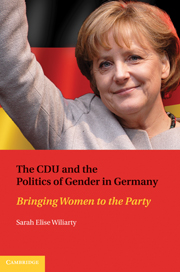Book contents
- Frontmatter
- Contents
- List of Figure and Tables
- Acknowledgments
- The CDU and the Politics of Gender in Germany
- Introduction: A Democratic Paradox?
- 1 The Puzzle of CDU Policy Making on Women's Issues
- 2 The Corporatist Catch-All Party Model
- 3 The Postwar CDU: Origins of a Corporatist Catch-All Party
- 4 The Emergence of the Women's Union, 1969–1982
- 5 The Women's Union in the Dominant Coalition, 1982–1989
- 6 Looking Eastward: The Women's Union and Cobbled Coalitions, 1989–1998
- 7 The Rise of Angela Merkel: Policy and Personnel Decisions of the CDU in Unified Germany
- 8 Christian Democracy With and Without Corporatism: Policy Making on Women's Issues in Austria, Italy, and the Netherlands
- 9 Conclusion
- Appendix: List of Cited Interviews
- List of References
- Index
5 - The Women's Union in the Dominant Coalition, 1982–1989
Published online by Cambridge University Press: 17 November 2010
- Frontmatter
- Contents
- List of Figure and Tables
- Acknowledgments
- The CDU and the Politics of Gender in Germany
- Introduction: A Democratic Paradox?
- 1 The Puzzle of CDU Policy Making on Women's Issues
- 2 The Corporatist Catch-All Party Model
- 3 The Postwar CDU: Origins of a Corporatist Catch-All Party
- 4 The Emergence of the Women's Union, 1969–1982
- 5 The Women's Union in the Dominant Coalition, 1982–1989
- 6 Looking Eastward: The Women's Union and Cobbled Coalitions, 1989–1998
- 7 The Rise of Angela Merkel: Policy and Personnel Decisions of the CDU in Unified Germany
- 8 Christian Democracy With and Without Corporatism: Policy Making on Women's Issues in Austria, Italy, and the Netherlands
- 9 Conclusion
- Appendix: List of Cited Interviews
- List of References
- Index
Summary
The 1980s provide an excellent illustration of the power an internal organization of the CDU can have when it is in the dominant coalition. During most of this decade, the Women's Union and its allies, the Social Committees, could control much of CDU policy making. During the 1980s, the Women's Union persuaded the CDU to provide not only child-raising money, but also employment guarantees for parents returning to work. The dominant coalition was also able to prevent proposed policy change restricting abortion. The Women's Union furthermore convinced the CDU to adopt measures designed to increase women's participation in the party.
In the early 1980s, the CDU returned to power after having been in the opposition since 1969. The Christian Democrats were able to regain control of parliament when the FDP defected from its coalition with the SPD in 1982. The new governing coalition, consisting of the CDU, the CSU, and the FDP, was ratified by elections in 1983. This change of power was heralded and marketed as a “Wende,” a turning point. Although the plan was to turn in a conservative direction, policy changes remained incremental, especially compared to the United States and Britain, two other countries also going through conservative turns during this period. Moreover, with regard to women's issues, the CDU not only did not move in a conservative direction; it generally accommodated women's demands.
- Type
- Chapter
- Information
- The CDU and the Politics of Gender in GermanyBringing Women to the Party, pp. 108 - 133Publisher: Cambridge University PressPrint publication year: 2010



